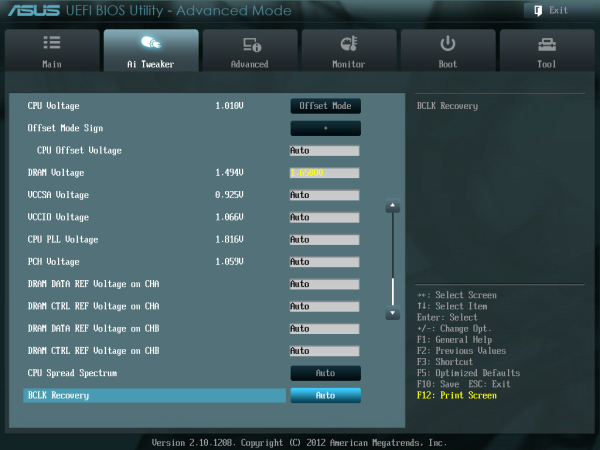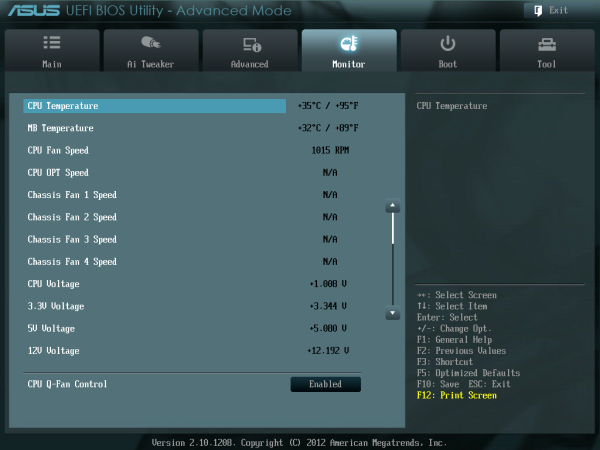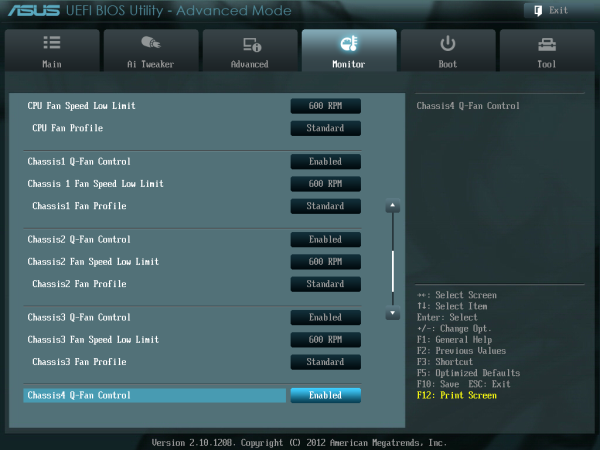ASUS P8Z77-V Deluxe Review - Know Your SKU
by Ian Cutress on May 12, 2012 8:45 AM EST- Posted in
- Motherboards
- Asus
- Z77
ASUS P8Z77-V Deluxe BIOS
In the past, when you had seen one BIOS then you had generally seen them all - white text on blue screens (or white on black if you were lucky). Now that we are firmly in an era of graphical interfaces and user operability, as users we get to see and play with the combination of designs that teams and BIOS engineers can envisage. Leading the field during P67 was ASUS, but now with Z68 and X79 out of the way, MSI and Gigabyte have been hot on their heels in an attempt to offer a superior experience.
The problem with consecutive iterations of innovation is how to innovate next - more functionality, or improvements on current functionality? ASUS will perhaps have to invest in deciding which direction to take over the next few chipsets - but nevertheless, the BIOS we have access to today is still very well thought out, easy to use, and one of the better graphical BIOS implementations for users and enthusiasts to enjoy.
The initial screen as we may all know by now for ASUS products is the EZ Mode - showing everything a user needs to know about what they have just bought or are using. We have the board model and BIOS version (always important to know without opening up a case to find out or loading CPU-Z), CPU type and speed, memory amount and speed, CPU/chipset temperatures, as well as voltages and fan speeds. For ease of use, system performance can be adjusted for low power, normal, or high performance. The boot priority is also changed by dragging drives into their appropriate positions. Pressing F3 will bring up shortcuts to the main sections in Advanced Mode, whereas F8 offers a one-time boot choice for the next boot (useful for installing OSes in my case).
Advanced mode is where the meat of the BIOS action happens as per usual, with AI Tweaker holding all the overclocking secrets a general enthusiast could want. Users coming from ROG boards will find far fewer options on the Deluxe than on ROG boards, as the Deluxe focuses on delivering secure performance rather than bleeding edge - this may discourage a few extreme (sub-zero) overclockers, but chances are those users will be heading for ROG anyway. For the rest of us, the main option is 'AI Overclock Tuner', which offers Auto/Manual/XMP options.
Under XMP, the following options are opened up, with 'core ratio limit' determining the multiplier. The BCLK Frequency is also adjustable. When pushing the CPU above 4.6 GHz, it is recommended that Internal PLL Overvoltage be set to enabled. XMP is automatically set in this mode, including memory strap, voltage and subtimings. These can also all be adjusted as required.
Voltages are set below the main settings, and the DIGI+ VRM option allows adjustment of all the digital power delivery - CPU, DRAM and iGPU as required.
The main other section of the BIOS for users is the fan controls, found in the Monitor section. This shows the current temperature and fan speed settings, while underneath gives the variety of fan controls to which we are accustomed to with ASUS - actual numbers in terms of RPM and temperatures, rather than obscure units that some other manufacturers like to use. It is also worth pointing out that alongside all the fan headers supporting 4-pin fans, the chassis fan headers also support 3-pin fan control due to the upgraded fan controllers ASUS use.
ASUS also offer saving of OC Profiles, and an easily updateable BIOS through EZ Flash as long as you have a USB stick with a BIOS downloaded on to it.
It is very hard to criticize an ASUS BIOS, as it does almost everything really well. Other features I would like to see included are perhaps an Internet BIOS Update in the BIOS (like ASRock), graphs representing the fan controls (if possible) or perhaps an option to turn off all lights on the board (for dark gaming experiences).
Software
For the last few generations of motherboards, ASUS has pushed their AI Suite software. Acting as an all-in-one interface, AI Suite aims to bring all the separate areas of ASUS functionality into the same, consistent implementation so nothing catches a user by surprise (or fills the spare memory of a PC with 18 different processes).
AI Suite covers the following features:
TurboV Evo: Overclocking Settings, Auto and Manual
DIGI+ VRM: Power delivery settings for CPU and Memory
EPU: Energy Saving
Fan Xpert II: Fan testing and controls, featuring full automatic testing of fans and user-changeable configurations.
Probe II: Monitoring of on-board factors (temperature, fan speeds, voltages)
AI/USB Charger: Quick device charging utilities
USB 3.0 Boost: Superior USB performance on any USB 3.0 port using the UASP protocol
Network iControl (NiC): Priority configuration of software through network ports
SSD Caching: Integration of Z68 SSD Caching on Z77
USB BIOS Flashback: Set up a USB to flash a BIOS without any CPU/Memory/GPU required.
Our P8Z77-V Pro review covered AI Suite II, as well as USB 3.0 performance, in detail.




























52 Comments
View All Comments
maximumGPU - Monday, May 14, 2012 - link
yes as Ian just said, my fans are 3 pin and plugged into the chassis headers. Fan Xpert can adjust their speed. i have a pwm 4 pin fan on the CPU header so can't tell you if that header can control 3 pin.i do not know how the control is done though.
DarkRogue - Monday, May 14, 2012 - link
All right, thank you to the both of you.I don't have any PWM fans, so I guess I will be the guinea pig for when I get the Z77 Deluxe board. It is good to know the other headers are capable of controlling regular 3-pin fans, though.
Ian, I know bugs are good to report, but I meant that a review of the software itself, such as the features it provides and how well it works, etc., would be a good supplement to a motherboard review. Again, the software is one other aspect the manufacturers are trying to differentiate themselves (I mean, look at the UEFI styles!) and it would be helpful to see how well their software works, or if similar things can be achieved with other software. Not everyone has used a board from every manufacturer before, nor know what use each piece of software provided is for, or how easy it is to use to achieve its intended function.
I just feel that with a review, it's helpful to review every aspect, and not just the hardware. Personally, I've never used any motherboard-supplied software because they've always been really buggy or annoying to work with, particularly Gigabyte's programs that kept auto-loading despite what I did until I just outright uninstalled it. It's been over 4 years since I've had an ASUS board, and I'll likely have to try AI Suite now to take advantage of Fan Xpert 2. Without seeing ASUS' video presentation of this feature, I would've skipped it and went with the cheaper Gigabyte board, and have to buy additional fan controllers, because Gigabyte's fan headers are apparently inconsistent.
Anyway, it's just a suggestion that, in my opinion at least, would give motherboard reviews a more 'complete' overview.
gtm - Monday, May 14, 2012 - link
I find Thunderbolt interesting for the ability to put one big and loud pc in one room, and get all I/O in another room, saving noise, space and cable mess.But is it possible to wake an hibernating PC using for example an USB-Keyboard connected to a thunderbolt display?
gtm - Monday, May 14, 2012 - link
Sorry, posted for the wrong articleSuuave - Monday, May 14, 2012 - link
I'm building a server with a similar board in this series. I've looked on the Asus site and several review sites. But I cant seem to find the answerMy question is what video card would the built-in video chip be equivalent to? I have an old GT 9600, but should I use it or would it just be a waste of time, energy and effort to install it?
Breaker - Wednesday, May 16, 2012 - link
Greetings Ian!In the OC section of your Asus Z77 Deluxe review you said:
adjusted the Turbo Ratio 1-Core Limit
Can you be more specific pls?
Shane527x - Wednesday, May 23, 2012 - link
Hi guys, I just ordered my board few days ago but i still disnt order the memory.. I want 16, i was thinking to make a 16g kit 8x2 vengeance corsairbut I didnt see anywhere. So id like to know if i can actually do that or what is the best? Thank youHardwareDufus - Wednesday, May 23, 2012 - link
I thought the UEFI initiative was to replace the BIOS, no?So all of these Z77 boards still have a BIOS? We will still have the excessive Boot times?
Triniman - Monday, August 13, 2012 - link
Will the Front Panel USB 3.0 box work with the P8Z77-V Deluxe motherboard? The reason I ask is that the listing of supported chipsets does not show the Z77 chipset and yet the P8Z77-V Premium motherboard ships with the Front Panel USB 3.0 box and it uses the Z77 chipset.Reference:
(http://ca.asus.com/en/Motherboards/Accessories/Fro...
macmuchmore - Tuesday, September 4, 2012 - link
I just purchased a P8Z77-v Deluxe for $224.99 this last weekend. I cannot wait to get it installed this week.So did I get a good deal? ;-)
macmuchmore